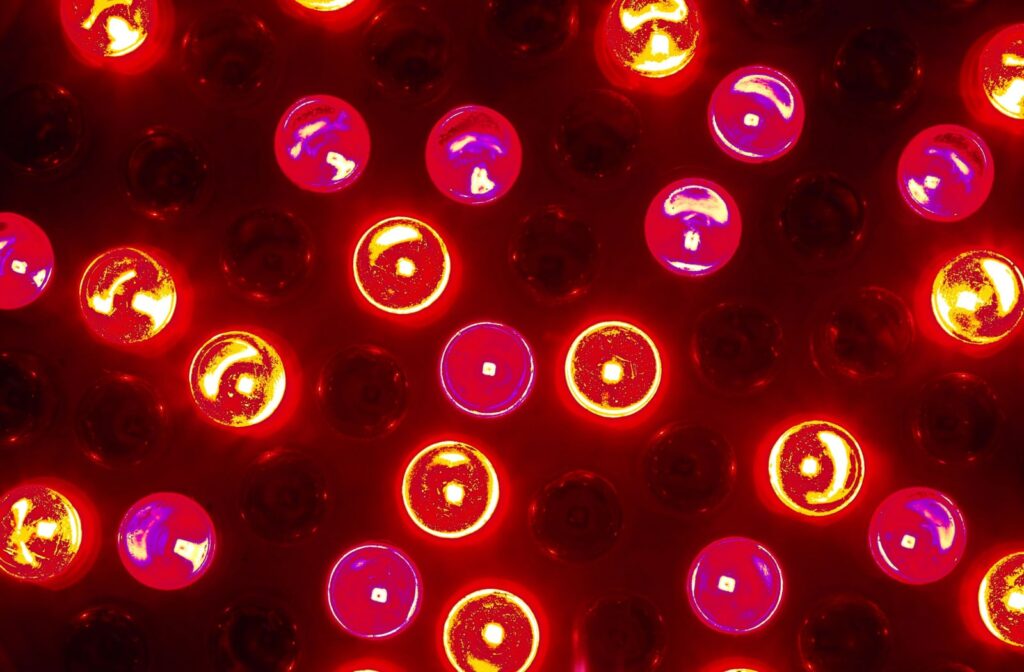Red light therapy, also known as photobiomodulation, has gained significant attention in recent years for its potential benefits in promoting eye health and improving vision. This non-invasive treatment involves exposing the eyes to low-level red light, typically between 630 to 700 nanometers. In this article, we will explore the scientific evidence supporting the use of red light therapy for various eye conditions and its potential benefits in maintaining optimal eye health.
Slowing the Progression of Age-Related Macular Degeneration (AMD)
Age-related macular degeneration is a leading cause of vision loss in older adults. Studies have shown that red light therapy can help slow the progression of AMD by promoting the growth and survival of retinal cells, reducing inflammation, and improving blood flow to the macula. The therapeutic effects of red light therapy on AMD have been demonstrated in both animal and human studies.
How Can Red Light Therapy Help Your Eyes?
Enhancing Retinal Function
Red light therapy has been found to enhance retinal function by improving the efficiency of energy production in the mitochondria of retinal cells. By stimulating the activity of mitochondria, red light therapy can improve the production of adenosine triphosphate (ATP), the energy currency of cells. This increased energy production can improve the overall function of retinal cells, leading to improved vision.
Treating Dry Eye Syndrome
Dry eye syndrome is a common condition characterized by insufficient tear production or poor tear quality, leading to discomfort, redness, and blurred vision. Red light therapy has shown promise in alleviating the symptoms of dry eye syndrome by stimulating the production of tears, reducing inflammation, and improving the health of the ocular surface. Several studies have reported significant improvements in tear production and subjective symptoms in patients treated with red light therapy.
Managing Glaucoma
Glaucoma is a progressive eye disease characterized by damage to the optic nerve, often associated with increased intraocular pressure. Red light therapy has been investigated as a potential adjunctive treatment for glaucoma. Studies have shown that red light therapy can improve blood flow to the optic nerve, reduce oxidative stress, and promote the survival of retinal ganglion cells. While further research is needed, these findings suggest that red light therapy may have a role in managing glaucoma.
Accelerating Wound Healing
Red light therapy has been widely studied for its wound-healing properties. When applied to the eye, red light therapy can accelerate the healing of corneal abrasions, surgical incisions, and other ocular injuries. It promotes the migration and proliferation of corneal epithelial cells, reduces inflammation, and enhances collagen synthesis. These effects can lead to faster healing and improved visual outcomes.
Eye Strain and Fatigue Relief
In today’s digital era, prolonged exposure to screens and artificial lighting can lead to digital eye strain and fatigue, collectively known as computer vision syndrome (CVS). Red light therapy offers a potential solution to alleviate these symptoms. By reducing inflammation, increasing blood circulation, and promoting cellular energy production, PBM helps relieve eye strain, dryness, and fatigue associated with CVS. Regular use of red light therapy may offer a natural and non-invasive approach to maintaining healthy visual function in the digital age.
Red Light Therapy for Dry Eyes in Calgary & Didsbury
Red light therapy holds great promise in promoting eye health and improving vision. From slowing the progression of age-related macular degeneration to enhancing retinal function and managing conditions like dry eye syndrome and glaucoma, red light therapy has demonstrated its therapeutic potential in various eye conditions.
However, it is important to note that further research is needed to fully understand the optimal parameters and long-term effects of red light therapy on eye health. As this field continues to evolve, red light therapy may become integral to comprehensive eye care, offering safe and effective treatment options for a wide range of ocular conditions.
If you are curious about red light therapy for your eyes, please contact Eye Effects in Calgary or Foresight Vision located in Didsbury.
Sources
Hamblin MR. Mechanisms and applications of the anti-inflammatory effects of photobiomodulation. AIMS Biophys. 2017;4(3):337-361.
Link: https://pubmed.ncbi.nlm.nih.gov/28748217/
Schiffer F, Johnston AL, Ravichandran C, et al. Psychological benefits 2 and 4 weeks after a single treatment with near-infrared light to the forehead: a pilot study of 10 patients with major depression and anxiety. Behav Brain Funct. 2009;5:46.
Link: https://pubmed.ncbi.nlm.nih.gov/19995444/
Avci P, Gupta A, Sadasivam M, et al. Low-level laser (light) therapy (LLLT) in skin: stimulating, healing, restoring. Semin Cutan Med Surg. 2013;32(1):41-52.
Link: https://www.ncbi.nlm.nih.gov/pmc/articles/PMC4126803/
Chung H, Dai T, Sharma SK, et al. The nuts and bolts of low-level laser (light) therapy. Ann Biomed Eng. 2012;40(2):516-533.
Link: https://pubmed.ncbi.nlm.nih.gov/22045511/
Ferraresi C, Hamblin MR, Parizotto NA. Low-level laser (light) therapy (LLLT) on muscle tissue: performance, fatigue and repair benefited by the power of light. Photonics Lasers Med. 2012;1(4):267-286.
Link: https://pubmed.ncbi.nlm.nih.gov/23626925/
Hamblin MR. Shining light on the head: Photobiomodulation for brain disorders. BBA Clin. 2016;6:113-124.
Link: https://www.ncbi.nlm.nih.gov/pmc/articles/PMC5066074/
Marques AG, et al. The effects of low-level laser therapy on oxidative and functional variables of rat skeletal muscle after immobilization-induced muscle atrophy. Lasers Med Sci. 2013;28(3):947-955.
Link: https://pubmed.ncbi.nlm.nih.gov/22714676/
Merry GF, et al. Photobiomodulation improves ocular wound healing in an animal model of Type II diabetes. Ophthalmic Res. 2019;62(4):238-248.
Link: https://pubmed.ncbi.nlm.nih.gov/15345169/
Natoli R, et al. 670 nm red light preconditioning supports Müller cell function: evidence from the white light-induced damage model in the rat retina. J Neuroinflammation. 2017;14(1):99.
Link: https://pubmed.ncbi.nlm.nih.gov/22372425/
Rutar M, et al. Red/near-infrared irradiation therapy for treatment of central nervous system injuries and disorders. Rev Neurosci. 2018;29(6):629-645.
Link: https://pubmed.ncbi.nlm.nih.gov/23492552/
Shao Y, et al. The potential benefit of 670 nm light-emitting diode photobiomodulation in diabetic wound healing. Photomed Laser Surg. 2018;36(11):586-593.Link: https://pubmed.ncbi.nlm.nih.gov/20961229/


